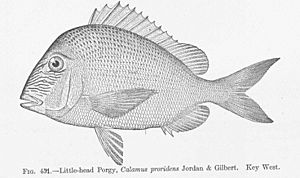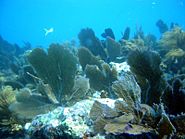Littlehead porgy facts for kids
Quick facts for kids Littlehead porgy |
|
|---|---|
 |
|
| Scientific classification |
The littlehead porgy (Calamus proridens) is a type of fish that lives in the ocean. It belongs to the Sparidae family, which is also known as the porgy family. You can find this fish in the western part of the warm, tropical Atlantic Ocean. People often catch littlehead porgies for food.
Two scientists, David Starr Jordan and Charles Henry Gilbert, first described this fish in 1884. They were both professors at Stanford University. An ichthyologist is a scientist who studies fish.
What Does the Littlehead Porgy Look Like?
When littlehead porgies are growing up, they are usually about 17 to 22 centimeters (about 7 to 9 inches) long. Fully grown adult fish are often around 37 centimeters (about 14.5 inches) long. Some have even been found to be as long as 46 centimeters (about 18 inches)!
Compared to other fish in their group, littlehead porgies have small scales. They also have bodies that are quite deep from top to bottom, with a steep slope from their head to their back.
All porgy fish have molar-like teeth. However, the littlehead porgy's teeth look more like canine teeth.
Littlehead porgies are mostly silver in color. They have pretty violet spots on their scales. These spots form stripes on the upper part of their bodies. Darker bars of color cross over these stripes. The littlehead porgy is known for being one of the most brightly colored fish in the porgy family. This family has over 100 different types of fish!
Where Do Littlehead Porgies Live?
Littlehead porgies are only found in the western part of the Atlantic Ocean. You can find them off the northeast coast of Florida and in the northern Gulf of Mexico. They also live in the Caribbean, stretching south to the Bay of Campeche (which is west of the Yucatán Peninsula) and northern South America.
These fish usually live near reefs. They like hard, spongy, or coral bottoms. They mostly eat small invertebrates, such as crustaceans. Invertebrates are animals without a backbone, like crabs or shrimp. Littlehead porgies often move between places where they eat and places where they lay their eggs.
See also
 In Spanish: Calamus proridens para niños
In Spanish: Calamus proridens para niños


